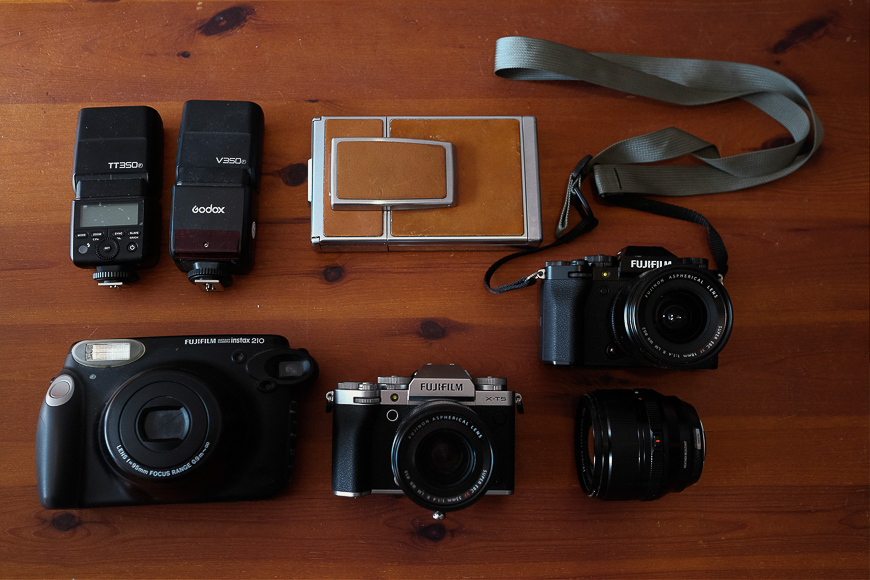
I’m a documentary/reportage wedding and family photographer based in Derbyshire, UK.
I like to get right in the middle of things, and I think small, light, tangible camera gear both lets me into the wedding and helps me keep my energy levels up for what can be (let’s face it) a very long day.
I also enjoy messing around with analogue and vintage cameras. I often take instant cameras (both Fuji and Polaroid) to weddings as I think they create something a bit different photographically and as an experience for the couple.
When I started out as a photographer, I used to be one who believed that having every focal length available was paramount.
I used the Nikon D700 and later the Nikon D800 and all the zooms.
As various parts of me started aching, I started stripping away gear. First, I moved to primes on Nikon bodies, and then, in 2016, I made the leap to Fuji with the Fujifilm X-pro 2.
Since then, I’ve been using Fuji cameras religiously whilst trying to strip my kit back to the bare minimum.
Plenty of bits have come and gone, but I’ve stripped it back to a camera and three lenses.
This has also allowed me to experiment with other formats—35mm, medium format (I think part of my Mamiya C330 got lost in a field in Shropshire while taking some wedding photos), and finally, settling into a groove with Instant Film.
I love the unpredictability and character it brings to a photo shoot.
Fujifilm X-T5 – I have been using Fuji XT cameras since 2016, and this one is currently most appealing due to its size and tangible feel. It feels like an extension of me now, and I can usually dial in the settings before bringing my camera to the eye.
The latest generation of Fuji cameras has great colour science and tends to nail the white balance, which makes editing much more straightforward.
The Fujifilm lenses have a nice balance between sharpness and a softer, almost vintage rendering.
Fujifilm XF 18mm f/1.4 R LM WR – As a documentary wedding photographer, a wide-angle lens is my bread and butter. This one has a 28-mm equivalent focal length and cures the decision paralysis I used to get from carrying a 24mm and 35mm.
Most of my photographs are taken on this, which is why it’s attached to the Simplr strap. Sometimes, I will carry the second body on my hip with the 33mm and 56mm attached.
Fujifilm XF 33mm f/1.4 WR – This is my telephoto, which is equivalent to a 50mm. It stays on the camera ninety per cent of the time, and on many days, this and the 18mm are the only two lenses I use. It’s great for portraits or having that little extra reach.
Fujifilm XF 56mm f/1.2 WR – This is an emergency lens for when I have to be a bit further away, say at the back of the church or speeches.
Polaroid SX-70 – my Instant Film Camera is a weird-looking thing that’s not even recognisable as a camera until it’s unfolded. It’s ISO 100 at f/8, so you can only use it on a sunny day or for making blurry photos. Both of these are things that happen regularly.
But the beauty is that you can manually do it, and f/8 on such a large surface gives you that blurry background, often blurring everything else on a cloudy day. It’s also a lot more random what you get out of it. I’m currently loving the Polaroid B&W film, so I have purchased loads more of that for future experiments.
Instax Wide 210 – Instant film camera. I always feel a bit cheated with how small the Instax mini prints are, and you can pick up an old Instax wide camera dirt cheap off eBay. They are unappealingly retro.
It’s of that age where it’s ugly and looks like the bastard love child of a VHS video and a 90s camcorder!
Still, the film in the Instax cameras is much faster than with my Polaroid (ISO 400, I believe, compared to the ISO 100 of Polaroid film). So you can use them on cloudy days and indoors a bit more.
I often find direct flash ugly, so I try to find some nice light to use it in.
Godox TT350-F – I have no idea where the battery charger is. I think I last charged it a few years back, which gives you some idea of how much use these two flashguns see. They’re mainly there for emergencies because I like to work with ambient light all day, even on the dancefloor.
The Godox TT350-F is the one I reach for, of course, because it takes standard batteries.
I love the Ona Brixton Bag and the Ona Bowery Bag for my type of work. I mainly picked them because they look really nice, but they also carry the stuff I need. The Ona Bowery Bag forces me not to carry too much kit.
I use Lightroom, and if I have to open Photoshop, it’s because I made a mistake. I like to keep my edits very natural.
I have custom presets built by Northern Presets. They work well with my cameras under different lighting conditions and have a filmic, contrasty look.
Website | Instagram






